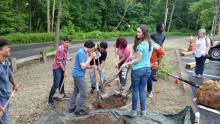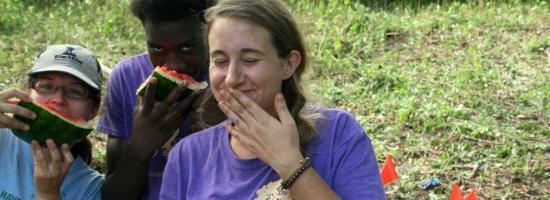2016 Report for Wintergreen Brook at Common Ground

Year
2016
Number of volunteers
21
Total volunteer hours
130
Number of events
12
Number of trees planted
0
Number of shrubs planted
38
Number of perennials planted
0
Yards compost spread
0.50
Yards mulch spread
2.00
Summary
This is the first year for the Wintergreen Brook at Common Ground High School as an urban oasis. The site extends along a section of the Wintergreen Brook across the street from Common Ground High School campus. It is a mixed deciduous forest that belongs to the Jewish B'nai Jacob congregation. At the beginning of this summer, the site had lots of invasive species, poison ivy and illegally dumped trash. The idea of this project came from Kathiana Torres, a senior at the school this year who wanted to make it her senior project. The idea was the forest to be maintained as a green space and inside of it, to have a core area that will be the urban oasis. After her project got approved by URI, the students presented the idea to the board of directors of the congregation who then granted them permission to carry out the activities to make it a reality. As an urban oasis, the site became part of the partnership between Common Ground High School, URI, United States Fish and Wildlife, the City of New Haven, the Peabody Museum and Audubon Connecticut. This summer the school enlisted 2 different student crews from the school who worked to lay the ground work for the oasis. The goals they set for this summer were: clean up trash, removing invasive species, creating trails, and creating the urban oasis. Since then the site has been a great educational space for the students because they were involved in all steps of the process; from the conceptualization and design of the site to the physical work. They created a map for it, and they had some plant identification exercises for the most common invasive species on the site before they could start removing them. They created a trail that goes to and around the oasis and covered it with woodchips, planted native plants, focusing on the ones that provide food and good habitat for the birds, like the low brush blueberries, winterberries, mountain laurels, nine barks, autumn brilliance etc. They learned to identify and removed invasive species such as: mugworth, Norway maple, garlic mustard, multifloral roses, Japanese knotweed, Japanese barberry, etc. This fall the group wants to install nesting boxes and to extend the trails and install benches around the oasis to increase educational access. For the future they want to keep working on improving habitat quality and extend the trail all the way to a community garden a few miles further north.
